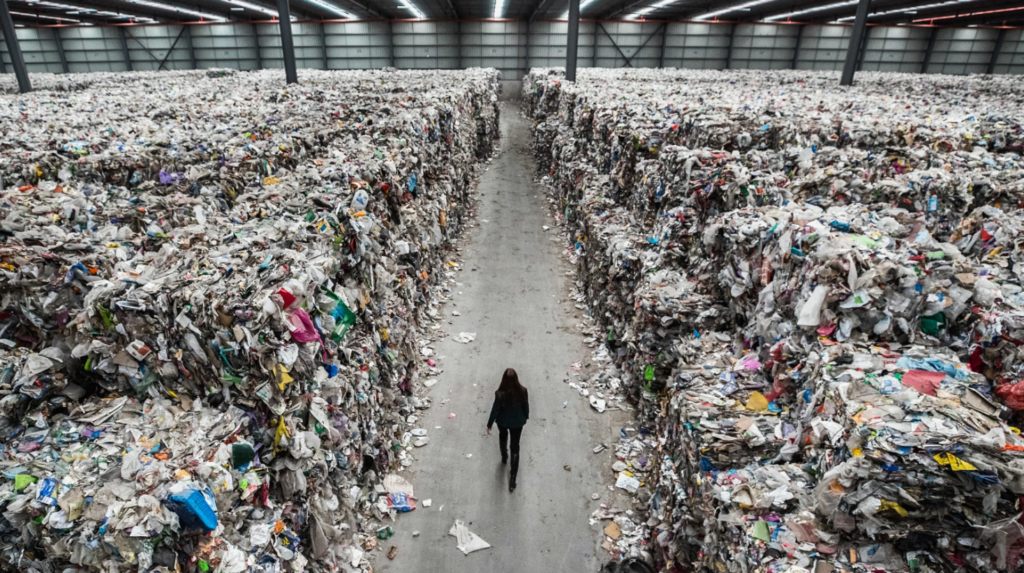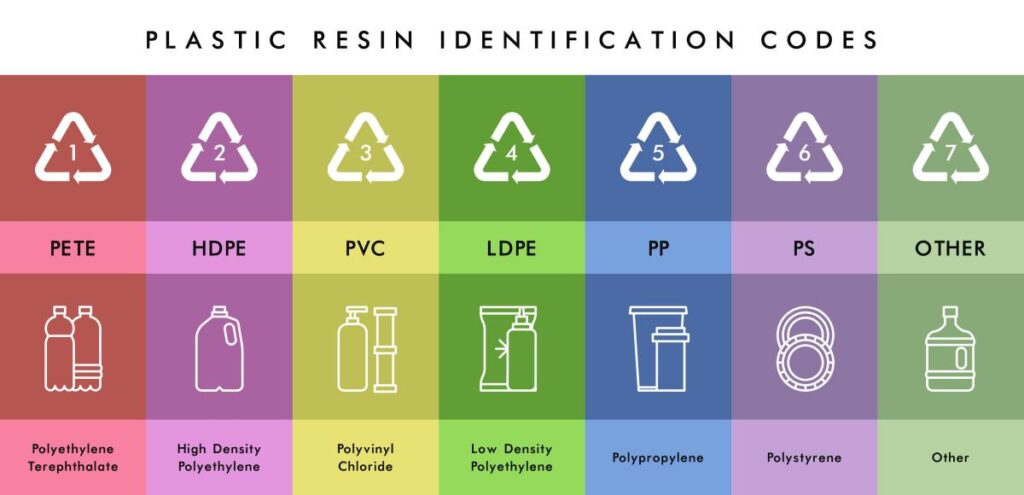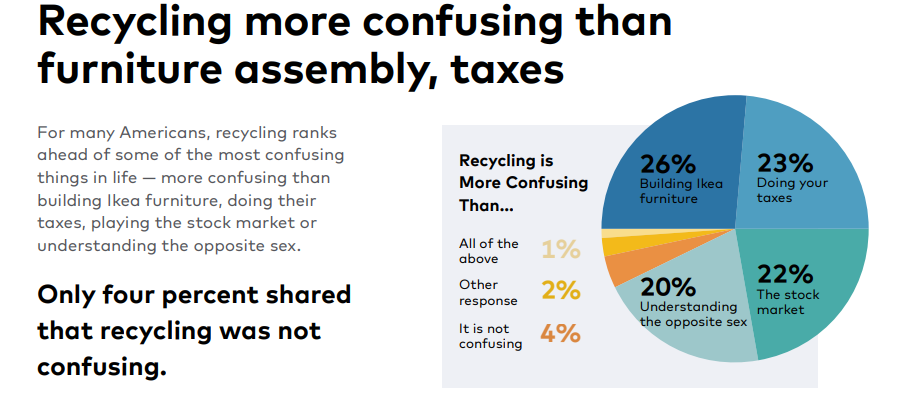Lies, damn lies, and marketing. … or something like that.
If I had $1,000 for every time I’ve had to explain to someone that terms like “environmentally friendly” aren’t regulated and don’t actually mean anything, I could probably launch my own ethically-focused, truth-in-advertising marketing firm. But even that wouldn’t get me far because I’d still be up against companies putting “environmentally friendly” on their packaging.
One of the biggest and longstanding examples of the proverbial wool getting pulled over our eyes as consumers is the ubiquitous use of the “chasing arrows” symbol on plastic products and packaging. It is important to stress – especially now, at the beginning of another Plastic Free July – that if you see this symbol on plastic, it does not mean that the item is made from recycled plastic, nor it does not mean the item will get recycled. The symbol is currently unregulated for use, but it is pervasive in our society as a perceived indicator of responsible behavior – and the plastics industry counts on our ignorance so we will keep buying their products.
Decades of Misdirection
I have written before on the blog about how little plastic actually gets recycled (about 9% globally), [1] how many “recycling” programs don’t actually involve closed-loop recycling, despite their use of the “R-word,” [2] and the serious environmental and health impacts related to plastic manufacturing and plastic incineration (a.k.a. “advanced recycling” or “chemical recycling”). [3] Despite the available facts, our perceptions still lag, and our “business as usual” behavior is encouraged by the presence of a symbol that we have been taught for most of our lives to be a good thing.

Image credit: [4]
In fact, the inaugural post on this blog was inspired by neighbors of mine who complained to me about changes to our single-stream, curbside recycling program, believing that much of our plastic would no longer be recycled by our municipality. [5] They were dismayed when I explained that it was never recycled in the first place; merely collected to be landfilled or incinerated. But they, very educated and responsible people, had no idea – and that has been the case for most of us, at least up to now.
California recently took steps to improve consumer awareness when it comes to products that bear the “chasing arrows” symbol or other terminology that would imply environmentally responsible behavior. SB 343, which was signed into law by Gavin Newsom on October 5, 2021, is designed to better regulate claims about recyclability of consumer products. Products and packaging that don’t meet California’s recyclability standards are not allowed to suggest that they are recyclable with words or images, including the “chasing arrows” symbol.
Setting Standards
When it comes to regulating terminology that has been poorly defined for decades, it takes time (and negotiations) to gather information and set standards. Under SB 343, a material is considered “recyclable” if it is collected by recycling programs serving at least 60% of the state’s population, AND if it can be sorted into recycling streams for processing by at least 60% of the state’s recycling programs. The law further stipulates that materials cannot contain substances that prevent them from being recycled, chemicals limited by existing CA regulations, or PFAS. [6] Note: certain materials will be allowed if they are collected and reused or reprocessed into new materials or packaging, and the cynic in me is curious to see what ultimately slips through that loophole.

Image credit: [7]
And when it comes to creating new regulations, it takes time for companies to shift their behavior. When the bill was signed into law, its requirements were set to take effect on either January 1, 2024 or 18 months after a required material characterization study performed by California’s Department of Resources Recycling and Recovery (a.k.a. CalRecycle) was released, whichever date was later. As of the writing of this post, January 2024 is less than six months away, but that is when CalRecycle plans to release their preliminary findings. They then intend to hold a public hearing, followed by a public comment period, and then publish the study within 60 days of the public meeting.
While there is no target date listed for the public meeting, their website indicates that they are planning for the study to be out in March or April 2024. The subsequent study is scheduled to be completed in 2027, with future updates taking place every five years. [8]
If CalRecycle sticks to their schedule and releases the initial report, therefore starting the clock, by April 30, 2024, that means the new regulations will not take effect until November 1, 2025, more than two years from now, and more than four years after SB 343 was first signed into law.
In the Meantime
Two or more years is still a long time off, particularly when the plastics industry is projecting to double production in the next two decades, [9] which means that new plastic manufacturing facilities are getting designed, permitted, and built now. And SB 343 is just for California, a state that is often a world away from the rest of the United States on environmental policy. There is encouraging work being done on the global level, particularly by the Intergovernmental Negotiating Committee on plastics pollution (which held their second session one month ago in Paris [10]), but again, the pace of governmental action can seem glacial, even in times of crisis.

Image credit: [11]
What we can do now, as individuals, as consumers, as voters, is to get involved and get vocal. And Plastic Free July is a great time to do just that:
- The Plastic Free July website has resources and events so you can learn more about the issue and what individual actions you can take to reduce your impact [12]
- In addition to that, I would encourage you to write or call your elected officials – local, state, [Pennsylvania: 13] and US [14] – to let them know how you feel about plastic pollution and truth in advertising… and remind them that you vote
- While you’re at it, you can also refrain from buying single-use plastics, prioritize buying products with less packaging, and ask your local grocery stores to follow suit with more responsible policies [15]
I wish you a happy, informed, and impactful Plastic Free July. If you are trying something new this year or returning to something that has worked for you in the past, I would love to hear about it below.
Thanks for reading!
[1] https://radicalmoderate.online/plastic-free-july/
[2] https://radicalmoderate.online/plastic-waste-options-in-pittsburgh/
[3] https://radicalmoderate.online/plastic-free-july-2022-part-2/
[4] https://www.rollingstone.com/culture/culture-features/plastic-problem-recycling-myth-big-oil-950957/
[5] https://radicalmoderate.online/new-recycling-guidelines-in-the-south-hills/
[8] https://calrecycle.ca.gov/wcs/recyclinglabels/
[9] https://www.iso.org/news/ref2792-1.html
[12] https://www.plasticfreejuly.org/resources/solutions/
[13] https://www.legis.state.pa.us/cfdocs/legis/home/findyourlegislator/
[14] https://www.congress.gov/members/find-your-member
1 Comment
Jalen · July 9, 2023 at 1:22 pm
Thanks to a certain someone, I have 3 boxes in my basement for sorting plastics and taking them to a recycling center that theoretically recycles them. The boxes for cans, glass, styrofoam, electronics, and textiles are on me though.